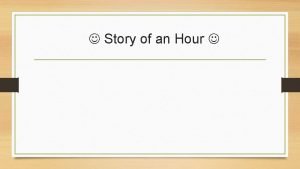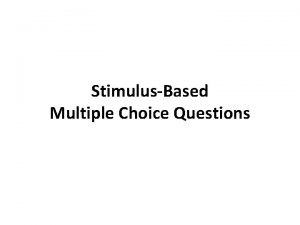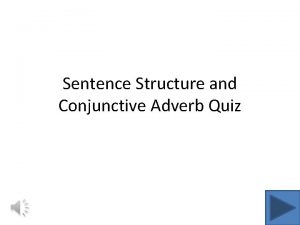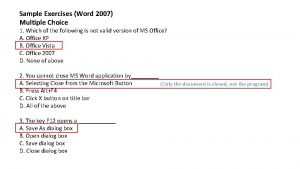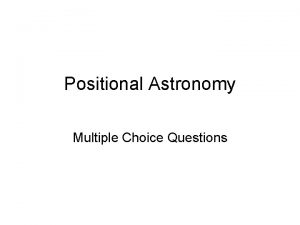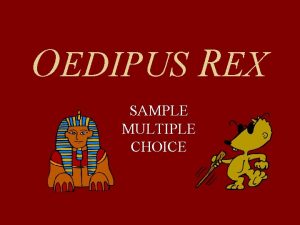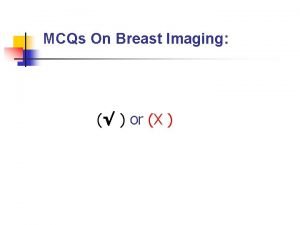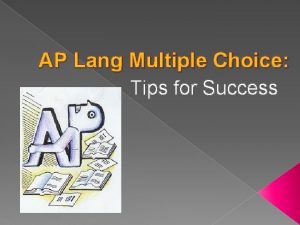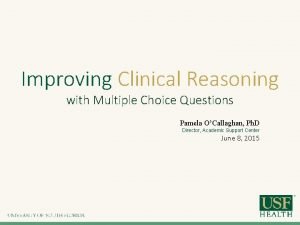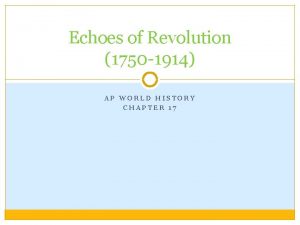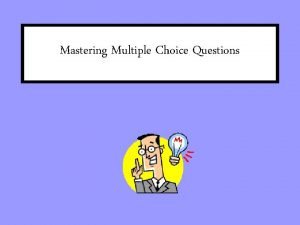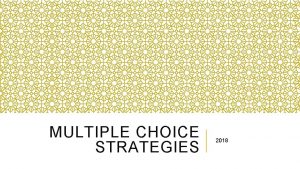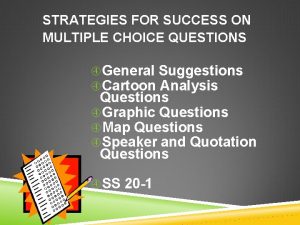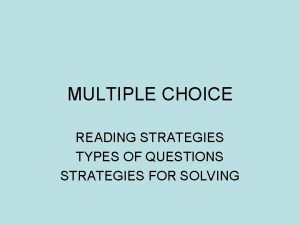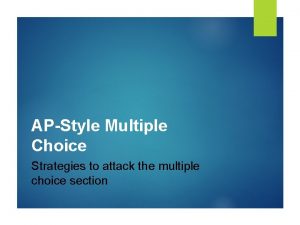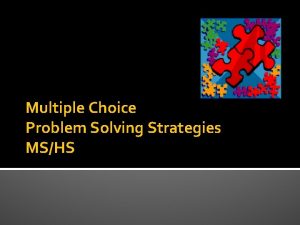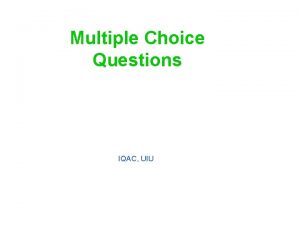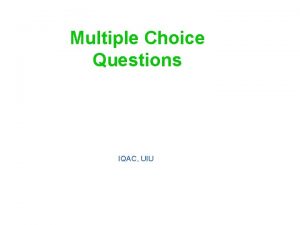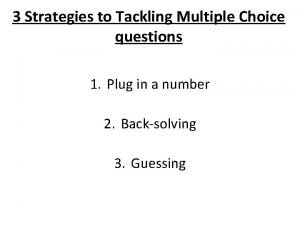STRATEGIES FOR SUCCESS ON MULTIPLE CHOICE QUESTIONS S

























- Slides: 25

STRATEGIES FOR SUCCESS ON MULTIPLE CHOICE QUESTIONS S 1 0 S 3 • General Suggestions • Cartoon Analysis Questions • Graphic Questions • Map Questions • Speaker and Quotation Questions

¨ GENERAL QUESTION STRATEGIES – there are several approaches that can improve multiple choice test writing skills. You should practise these suggestions and attempt as many as possible prior to writing final examinations. – Answer all questions; the correct answer is there!! – There is a single best answer that can be determined by using cues and clues.

GENERAL QUESTION STRATEGIES CON’T: – Read every word in each question, noting if the question is political or economic. – Underline and make notes in the margins while reading. – Cross out answers that are wrong, misleading, or off topic. – Cover up the provided answers, supplying your own answer, and finding the choice that most closely matches your own. – Read all answers to the questions before reading the question.

GENERAL QUESTION STRATEGIES CON’T – If the question refers to a specific source, speaker, or term provided on the test, read all available information to make certain the context is clearly understood. – When reviewing answers, do not change answers unless an obvious error is noticed.

1. Which of the following statements best reinforces the idea that personal identity can become closely tied to one’s ideological beliefs? A. People regarded as being liberal-minded often support laws designed to preserve personal freedom. B. During provincial elections a large portion of Alberta’s eligible voters either choose to, or do not bother to vote. C. The use of a secret ballot in Canada helps ensure that the choice the voter makes will remain confidential if the voter so chooses. D. Some people, when asked to describe themselves, will refer to their political affiliation, such as “social democrat” or “fiscal and social conservative. ”

2. With which of the following statements would a supporter of economic globalization likely agree? A. The liberalization of trade among countries has allowed individuals access to lower priced goods. B. The concentration of profits in the hands of transnational corporations is beneficial for consumers. C. The inclusion of protectionist policies is essential in the formation of international trade organizations. D. The increase in human-rights violations in many countries is regrettably necessary to increase efficiency in production.

¨ CARTOON ANALYSIS QUESTIONS – Editorial or political cartoons are often used as sources for analyzing concepts such as leadership and ideology. – historical events and leaders are frequently portrayed in editorial cartoons

¨ CARTOON ANALYSIS QUESTIONS – Each cartoon conveys a point of view or an opinion. The following questions can assist you in your analysis of editorial or political cartoons: • What is the context or time period? • When did the event, issue, or problem occur? . • What is the problem, issue, or event being dealt with in the cartoon? • Are there any real people in the cartoon? If so, who are they? • What is the cartoonist's view of these people?

¨ CARTOON ANALYSIS QUESTIONS • Are there any groups of representative figures in the cartoon? What is the cartoonist's view of these people? • Are there any details in the cartoons, such as names, dates, or symbols? • What bias(es) is presented in the cartoon? What is the cartoonist in favour of or opposed to? How is this shown? • What is the caption or title of the cartoon? What word(s) or phrase(s) is most meaningful? . What message is the cartoonist trying to communicate about the event, issue, or problem?

! ! N O I T A T I O L EXP "It's people like you, Mr. Evers, constantly living beyond your means, getting hopelessly deeper and deeper in debt to whom our industry owes eternal gratitude. " - from Economics: A Search for Patterns

3. In the cartoon, the cartoonist is being most critical of the capitalist system's underlying: A. Ethics B. Power C. Success D. Stability

4. Which of the following generalizations is best demonstrated through the situation depicted in the cartoon? A. Capitalism’s competitive nature is shown positively B. The loans industry is to be regulated to prevent the abuse of customers C. A government run financial institution is shown to be superior than one that is privately operated D. Capitalist businesses do not always act in the best interests of their customers.

¨ GRAPHICS – Charts, diagrams, tables, and other graphic sources require you to analyze and interpret information. – Careful reading of the key words and data can establish the context of the sources. – Noting details by highlighting, underlining, and circling key numbers, changes, and details can help to identify the major ideas, events, concepts, or trends illustrated. – Using key words from the questions and choices allows you to select the most appropriate information.

Voters have shifted to the “right”e Different ideologies = different beliefs and values

Conservative thinking! 5. In 1999, most citizens of Nation X would likely have voted for political parties that promised: A. less government intervention in the economy B. Less opportunity for workers to be exploited C. Higher taxes on large corporations D. Increased welfare benefits for all

-MAP QUESTIONS • Examination questions that use map sources require attention to specific details as well as spatial thinking. Use the following questions to guide your analysis of maps. • What year or period of history does the map represent? • Is there a title? If so, treat the title as a guideline for the major idea(s) to be addressed. If not, what title would be more appropriate and why? • Note that the nations, actions, locations, and events contained in the map provide clues as to the time period as well as the questions asked.

¨ MAP QUESTIONS – Are the dates appropriate for the map and event(s) in the source? – Does the title agree with the information provided? – What concept or idea is most closely associated with this map?

21 st Century Northern Nation-States 6. In an ideological sense, the darkened countries on the above map are most historically associated with: A. Nations that share northern frontiers he t r e B. Nations that have differing world views b ! m C. Nations that have produced nuclear weapons me rum Re ect D. Nations who today share similar values Sp

7. An appropriate title for the map most likely could be: A. “Cold War Tensions Decline on the Continents” B. “Nationalist Uprisings Create Hemispheric Upheaval” C. “Regional Boundaries Co-exist Alongside Political Differences” D. “The North Reshaped by Decisions Made at in Washington”

¨ SPEAKER AND QUOTATION SOURCE QUESTIONS – The use of speaker questions as well as those including quotations present challenges for test writers. – It is imperative to identify the point of view as well as the key ideas presented in each text source. These suggestions can aid you in answering such questions. – Underline or highlight key words and terms in each quotation or text source to identify the point of view most clearly associated with those terms.

¨ QUOTATION SOURCE QUESTIONS – Identify the ideological stance of the speaker questions which range on a spectrum of views such as radical, liberal, conservative, and reactionary. Noting the ideological stance by identifying key words, phrases, and terms allows the source to become an aid in answering the questions rather than an obstacle.

Use the quotations below to answer questions 8 and 9. SPEAKER I People will always be incapable of handling their own affairs. They are easily deceived and readily swayed by appeals to emotion since the vast majority are decidedly lacking in ability and refinement. Rabble-rousers are more likely to be elected than candidates that are the most qualified to hold public office. SPEAKER II I have confidence that the mass of the people can make broad decisions with intelligence if all relevant information can be placed before them, if the issues can be fully discussed, if the problems are not too technical for the average person, and if there is time for democratic judgments to take hold.

People are not logical thinkers, only the elite should lead – ultra conservative sentiment SPEAKER I People will always be incapable of handling their own affairs. They are easily deceived and readily swayed by appeals to emotion since the vast majority are decidedly lacking in ability and refinement. Rabblerousers are more likely to be elected than candidates that are the most qualified to hold public office. SPEAKER II I have confidence that the mass of the people can make broad decisions with intelligence if all relevant information can be placed before them, if the issues can be fully discussed, if the problems are not too technical for the average person, and if there is time for democratic judgments to take hold. People are logical thinkers and the democratic process can work – liberal sentiment

8. The opinion expressed by speaker 2 when compared to speaker 1 would be most likely indicative of: A. A thinker who would be supportive of reactionary and elitist ideals. B. A society based upon the will of the people and the rule of law. C. A society that would be to the far left of center on the political spectrum. D. An irresponsible point of view in connection with Rousseau’s thoughts on the nature of society.

9. With which of the following statements would both speakers most likely agree? A. Human nature drives most people to embrace collectivist values. B. Government’s sole purpose is to enhance the liberty of an individual. C. Political decisions must be made with consideration to what would most benefit a population D. Political leadership in a country must be assumed by those with superior intellectual ability.
 Math multiple choice test taking strategies
Math multiple choice test taking strategies How to write multiple choice questions
How to write multiple choice questions O be thou damned inexecrable dog
O be thou damned inexecrable dog She carried herself unwittingly like a goddess of victory
She carried herself unwittingly like a goddess of victory What is stimulus in mcq
What is stimulus in mcq Multiple choice questions on sentence structure
Multiple choice questions on sentence structure Exercises for microsoft word
Exercises for microsoft word Stimulus-based questions examples
Stimulus-based questions examples Astronomy questions and answers multiple choice
Astronomy questions and answers multiple choice Persuasive writing mcqs with answers pdf
Persuasive writing mcqs with answers pdf Oedipus multiple choice questions
Oedipus multiple choice questions Multiple choice questions on shakespeare sonnets
Multiple choice questions on shakespeare sonnets Stem cell multiple choice questions
Stem cell multiple choice questions Mammography mcqs
Mammography mcqs Growth mindset multiple choice questions
Growth mindset multiple choice questions Biomes multiple choice questions with answers
Biomes multiple choice questions with answers Tips for ap lang multiple choice
Tips for ap lang multiple choice How hard is alteryx core certification
How hard is alteryx core certification Multiple choice questions on ecotourism
Multiple choice questions on ecotourism Which command is used to set terminal io characteristic?
Which command is used to set terminal io characteristic? Tone multiple choice questions
Tone multiple choice questions Multiple choice questions on photoelectric effect
Multiple choice questions on photoelectric effect Multiple choice questions on flowering plants
Multiple choice questions on flowering plants Vignette style mcq
Vignette style mcq Abolitionist movement ap world history
Abolitionist movement ap world history Conjunctions exercises multiple choice
Conjunctions exercises multiple choice



